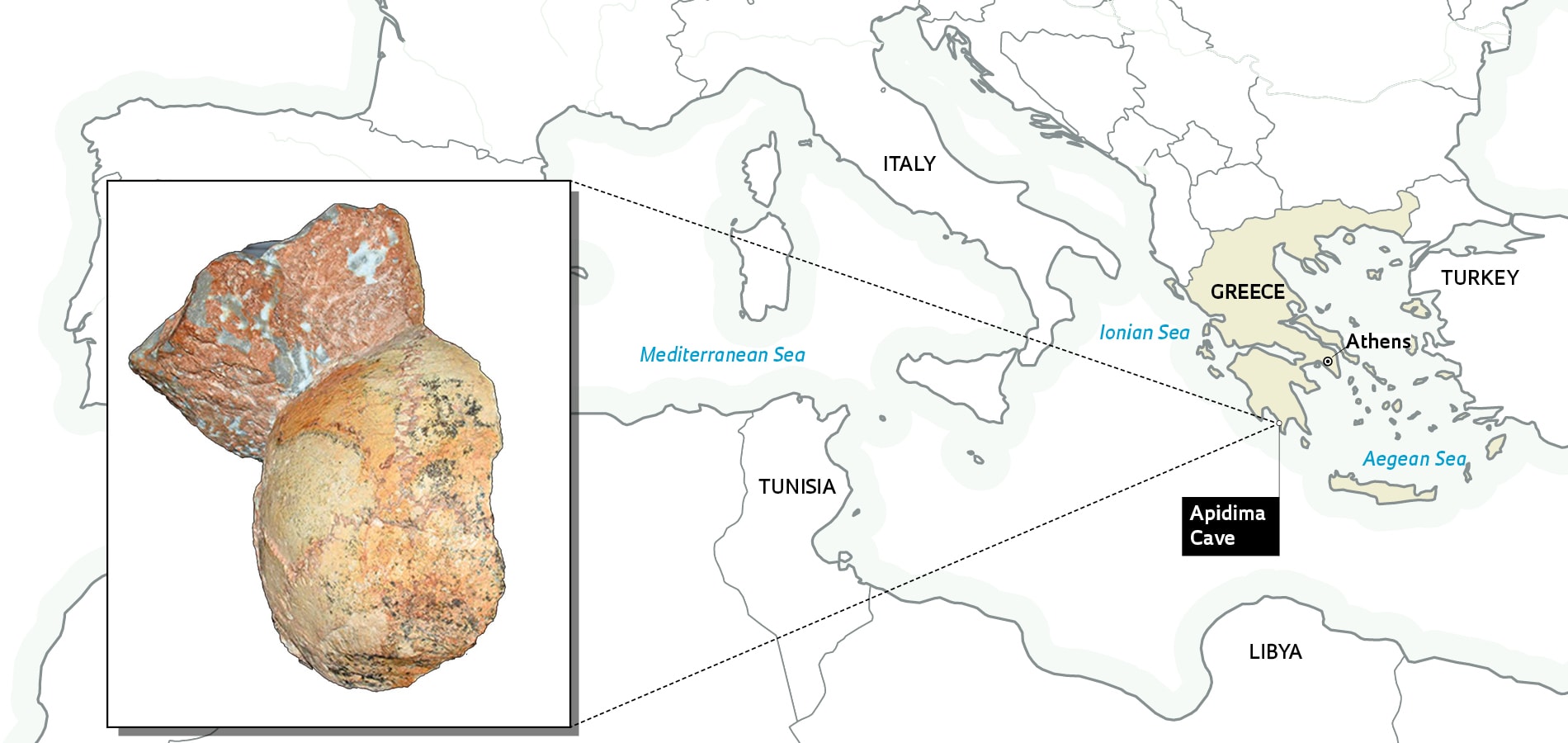In 1978, a team of researchers from the University of Athens found two incomplete hominin skulls in the Apidima Cave, off the coast of the Mani peninsula in southern Greece. Since then, the fragmented material, which was acquired in a geological context that makes dating difficult, had not been the subject of any research of significant impact. Last month, an article published in the journal Nature by the team of Greek paleoanthropologist Katerina Harvati of the University of Tübingen, Germany, put one of the skulls, named Apidima 1, at the center of a controversy. According to their research, the skeletal fragment probably belonged to a Homo sapiens who lived in the Peloponnese region 210,000 years ago.
If correct, this hypothesis would give Apidima 1 the status of being the oldest H. sapiens fossil found outside Africa, where modern man is believed to have originated approximately 350,000 years ago. Currently, the oldest fossil outside the African continent attributed to H. sapiens—although without absolute consensus—is a 190,000-year-old jawbone found in the Misliya Cave in Israel. Apidima 2, the other skull, is thought to be from a Neanderthal who inhabited the Mediterranean 170,000 years ago. The Neanderthals, a hominin species that occupied part of Eurasia before Homo sapiens, with whom they coexisted in some locations, went extinct around 40,000 years ago.
Harvati and her colleagues scanned the two skeletal fragments—Apidima 1 consists of the back of a skull, Apidima 2, the facial portion—and reconstructed their skull shapes by employing three-dimensional computer modeling techniques. “Although Apidima 1 is less complete, its rear part is different from that of Neanderthals and earlier hominins,” explains the paleoanthropologist. “We performed complete statistical analyses of its form and all the results point to the conclusion that it was a Homo sapiens. We were also surprised by the findings, and it’s natural that there is some skepticism among our colleagues.” With regard to the Neanderthals, this part of the skull is more rounded in modern humans, a feature which is present in Apidima 1. In the other skull, Apidima 2, the reconstructions indicate that its owner had a prominent superciliary arch—the bony bulge above the eye sockets—that is typical of Neanderthals.

HARVATI, K. et al. Nature. 2019 | MAP Alexandre Affonso
Apidima 1, the rear portion of skull found in a Greek cave that may have belonged to a Homo sapiens who lived 210,000 years agoHARVATI, K. et al. Nature. 2019 | MAP Alexandre AffonsoThe study’s findings are far from achieving a consensus. In June of this year, shortly before the article was published in Nature, French paleoanthropologist Marie-Antoinette de Lumley, from the Institute of Human Paleontology in Paris, released a 78-page pamphlet on the two Peloponnese skulls. In the booklet, she classified Apidima 1 and Apidima 2 as representatives of a group of Homo erectus, a more archaic hominin species than modern humans, which was evolving toward becoming Neanderthals. Lumley’s dating of the two skulls found an age of approximately 160,000 years, 50,000 years less than that obtained by the Harvati team for Apidima 1.
Other researchers also considered the 210,000-year-old age associated with the alleged H. sapiens skull fragment to be exaggerated. The authors of the Nature paper used a dating method based on the presence of certain atomic forms of the elements uranium and thorium in fossilized bone. The technique allows the dating of material up to 300,000 years old. According to Warren Sharp, a researcher at the University of California at Berkeley and an expert on uranium dating, the results of the analysis of the Apidima 1 fragments were inconclusive and provided dates ranging from 300,000 to less than 40,000 years. “The apparent dates span a long period and we don’t know if any one of them is really reliable,” Sharp told Science.
The search for remnants of different species of hominins that, at different times in prehistory, left Africa—from the most archaic species such as Homo habilis and Homo erectus, to the most modern, H. sapiens—is an issue subject to review and debate as new findings appear, which are almost always controversial. The Peloponnese skull fragments, in particular Apidima 1, will be one more such case. For Brazilian archaeologist Mark Hubbe of Ohio State University in the United States, the evidence found supports the conclusions of Harvati’s research. “We must always keep in mind that the Apidima 1 fossil is composed of only part of the neurocranium,” Hubbe observes. “I don’t doubt that it really is from a modern human. But right now it’s hard to tell how it compares to other H. sapiens fossils from Africa.”
Archaeologist Mercedes Okumura, from the Laboratory of Human Evolutionary Studies at the University of São Paulo (USP), takes a similar position. “The study has some unavoidable limitations, such as the geological context in which the fossils were found, the dating problem, and the fact that the supposed fossil from H. sapiens is very incomplete,” comments Okumura. “None of these limitations is the study authors’ ‘fault,’ and I think they did a good job of analyzing such difficult material.”
Scientific article
HARVATI, K. et al. Apidima Cave fossils provide earliest evidence of Homo sapiens in Eurasia. Nature. July 10, 2019.
